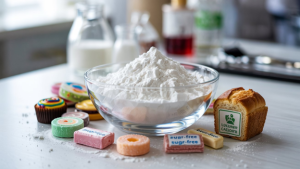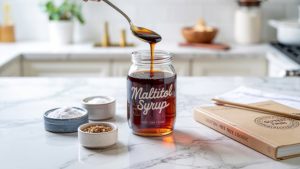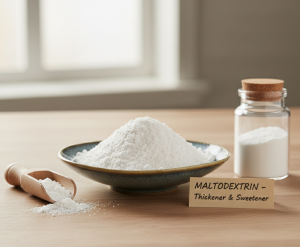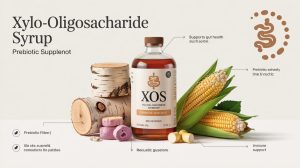Natural Isomalt Review — A Sweetener That Actually Gets the Job Done

Let’s be real: finding a sugar alcohol that’s actually pleasant to use — and not just “tolerable” — is harder than it should be. That’s why Natural Isomalt genuinely surprised me. It’s not just another sweetener riding the “natural” label. This one checks boxes for both the food engineer and the food lover in me.
Where It Shines: Real Industrial Potential
Before I dive into the taste and texture talk, let me say this upfront — if you’re in food manufacturing, this ingredient isn’t just a label decoration. It works.
✅ Low Hygroscopicity
This is a game-changer for hard candies, lozenges, and chewing gums. It doesn’t pull in moisture, so your products stay crisp and clean. No sticky mess during packaging, no need for silica gel packets or anti-caking agents. I’ve seen it used in pressed mints and pan-coated pellets — the stability is just chef’s kiss.
✅ High Thermal Stability
Tested it at 180°C in baked goods? Zero issues. No browning. No caramelization chaos. It’s highly resistant to Maillard reactions, which means your color-sensitive applications — like white protein bars or blondie-style keto brownies — stay visually on-brand.
✅ Ideal for Diabetic & Dental-Friendly Products
Its glycemic index is under 10 — significantly lower than maltitol or sorbitol — and it’s non-fermentable by oral bacteria, which makes it a go-to for sugar-free oral care. Think toothpaste, functional lozenges, kids’ dental chews. Plus, it meets EFSA and FDA thresholds for tooth-friendliness.
✅ Stable with Actives & Nutraceuticals
Whether it’s vitamin C, zinc, caffeine, or collagen peptides, Natural Isomalt offers excellent matrix stability. I’ve tried it in chewable supplements and thermally processed functional bars — no off-notes, no interaction mess. It’s a clean base that doesn’t get in the way.
✅ Compatible with High-Shear, High-Speed Processes
It blends like a dream. No lumping. No weird caking. I’ve tested it in extrusion (e.g., high-protein cereal puffs), roller compaction for tablets, and even in liquid premix concentrates. Smooth all the way. That saves time and reduces machine fouling — every ops manager’s dream.
✅ Label-Friendly, Globally Accepted
It’s recognized as GRAS in the U.S., and carries clean-label appeal for “sugar-free” and “naturally derived” positioning in most major markets — including the EU, ASEAN, and Australia. That’s one less regulatory headache when launching globally.
In short: it’s not just “useable” in industrial applications. It’s efficient. Reliable. And clean.
Taste & Texture: Honestly? Surprisingly Clean
Now, onto the fun part.
When I first tried it straight-up (yes, I always taste raw powders), I was expecting that weird cooling effect or bitterness that so many sugar alcohols have. But Natural Isomalt? Clean. Neutral. Zero weirdness. Almost like a sugar cousin who doesn’t try too hard.
- Sweetness is about 45–60% of sucrose, but it doesn’t feel “watered down” — it’s just…light.
- No throat-sticking. No film. No lingering metallic echo.
In protein bars or low-carb bakery products, it blends right in without stealing the spotlight. I paired it with stevia in a test batch of granola bars — magic. It mellowed out the stevia’s sharpness like a charm.
Digestive Friendliness: Two Thumbs Up
I tested it in different doses over several days (I tend to react quickly to polyols), and zero bloating, zero discomfort. For comparison: sorbitol messes with me within hours, and even xylitol sometimes overstays its welcome. But this one? Feels light. Feels safe.
What’s cool is, clinical studies back this up. According to a human tolerance study published in the European Journal of Clinical Nutrition, Isomalt was well tolerated at daily intakes of up to 30 grams, with significantly fewer gastrointestinal side effects compared to sorbitol or mannitol.¹
That really checks out with my personal experience. If you’re formulating for sensitive guts — or just want fewer complaint emails from customers — this is a solid choice.
| Ingredient | Typical Max Tolerable Dose (g/day) | Reported Side Effects | Source |
| Isomalt | Up to 30 g | Mild or no symptoms | Franck et al., Eur J Clin Nutr, 2002¹ |
| Sorbitol | ~20 g | Bloating, gas, laxative effect | Livesey, Regul Toxicol Pharmacol, 2001² |
| Mannitol | ~10–20 g | Strong laxative effect in many | Mäkinen, Int Dent J, 2010³ |
| Xylitol | ~30–40 g (split doses) | Bloating, gas | Mäkinen, Int Dent J, 2010³ |
Isomalt clearly shows higher tolerance with minimal discomfort, making it a safer bet for gut-friendly formulations — especially in functional foods, beverages, or supplements targeting sensitive consumers.
Market Trends & Consumer Appeal
The rise of keto, low-carb, and diabetic-friendly food markets means demand for sweeteners like Natural Isomalt is booming. Consumers are smarter and more label-conscious than ever. “Natural” and “tooth-friendly” are huge trust signals.
Interestingly, Isomalt’s ability to maintain product quality over shelf life without additional additives gives it an edge in the clean-label craze. Smaller brands are snapping it up for all sorts of “better-for-you” snacks, functional gummies, and even sugar-free confectionery.
Plus, with global diabetes rates climbing, food manufacturers are under pressure to innovate without compromising taste or texture. Natural Isomalt fits perfectly into this niche — delivering sweetness with a much lower glycemic footprint and fewer digestive complaints.
How It Stacks Up Against Other Sugar Alcohols
Compared to maltitol, sorbitol, and xylitol, Natural Isomalt stands out in several ways:
- Less Digestive Discomfort: Maltitol and sorbitol are notorious for causing bloating and laxative effects at moderate doses, while Isomalt is gentler on the gut.
- Better Thermal Stability: Unlike xylitol, which can degrade or brown at high temperatures, Isomalt keeps its composure, making it better for baked goods.
- Lower Hygroscopicity: Many sugar alcohols absorb moisture, causing stickiness and shelf-life issues. Natural Isomalt’s low moisture uptake means cleaner packaging and more stable products.
If your formulations have suffered from any of these common sugar alcohol pitfalls, this ingredient might just save your day.
Usage Tips & Considerations
- Start Low, Adjust Gradually: Despite its good tolerance, high doses of any polyol can cause digestive upset. If you’re new to using Isomalt, start at moderate levels and monitor consumer feedback.
- Combine Smartly: It pairs wonderfully with stevia, monk fruit, and other intense sweeteners, but balance is key to avoid aftertastes or texture issues.
- Watch for Crystallization: While stable, in high humidity or certain formulations, some crystallization can occur. Proper processing conditions and storage are essential.
Future Potential & Innovation
Natural Isomalt isn’t just a “now” ingredient — it’s got potential for future innovation. Research into prebiotic effects, synergistic blends with fibers, and even applications in personalized nutrition are underway.
As consumer demand grows for foods that do more than just satisfy hunger — delivering health benefits without compromise — ingredients like this will be central players.
How I’d Use It (and Why It’s Staying in My Lab)
If you work in R&D or product formulation, this is a versatile, low-risk tool to have on hand. It:
- Softens intense sweeteners (like monk fruit or stevia),
- Builds volume without messing with water activity,
- Helps stabilize moisture in protein bars, cookies, and fillings.
And if you’re a smaller brand making clean-label or keto-friendly foods, this might be your new not-so-secret weapon.
I didn’t expect to like it this much, honestly. Most sugar alcohols are functional, but kind of a flavor tax. This one? Functional and genuinely pleasant.
If you’re formulating anything that needs sweetness without sugar’s baggage — and you want something clean, non-aggressive, and easy to blend — give Natural Isomalt a serious look. It’s already earned a permanent spot on my bench.
References and Sources
¹ Franck et al., European Journal of Clinical Nutrition, 2002
² Livesey, Regulatory Toxicology and Pharmacology, 2001
³ Mäkinen, International Dental Journal, 2010
Related recommendations
-
Lactitol Monohydrate: A Clean-Tasting Sugar Alternative
577Sgnutri Supplies Lactitol And Ispaghula Husk Granules For Bulk Fiber Formulations In Digestive Health And Food Applications.
View details -
Is Maltitol Syrup Gluten Free? A Comprehensive Guide
646Maltitol Syrup Is A Gluten-Free Sweetener Used In Sugar-Free Foods. Learn What It Is And Why Sgnutri Recommends It.
View details -
What Foods Have Maltodextrin?
119Discover what foods contain maltodextrin, why it’s used as an additive, its benefits, and potential health considerations.
View details -
Xylo Oligosaccharide Syrup (XOS Syrup): A Smart Sweetener
588If you're in the food manufacturing game—whether it’s functional beverages, health snacks, or dairy alternatives—Xylo Oligosaccharide Syrup (XOS Syrup)&n...
View details
 SGNUTRI
SGNUTRI



